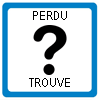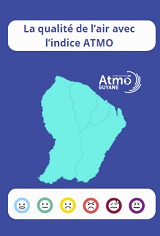Blada.com
vendredi 19 décembre
Boîtes aux lettres
Courrier des lecteurs
Petites annonces
Emploi / Formation
Covoiturage
Infos citoyennes
Infos citoyennes
16/08/22
L'animal du mois : Paraponera clavata
 Paraponera clavata est une espèce de fourmi bien connue appelée localement fourmi flamande, mais aussi fourmi 24h ou balle de fusil (une traduction du nom anglais de l’espèce) en référence à la violente douleur provoquée par sa piqûre. Elle se caractérise par une taille imposante jusqu’à 2,5 cm (une des plus grandes fourmis du monde, dépassée seulement de quelques millimètres par ses proches cousines amazoniennes Dinoponera). Commune sur le territoire guyanais, les Paraponera appartiennent à une tribu primitive de fourmis qui forment des colonies comptant peu d’individus (jusqu’à une centaine) et dont les castes sont très peu différenciées, les ouvrières et la reproductrice (la reine) étant quasiment identiques.
Paraponera clavata est une espèce de fourmi bien connue appelée localement fourmi flamande, mais aussi fourmi 24h ou balle de fusil (une traduction du nom anglais de l’espèce) en référence à la violente douleur provoquée par sa piqûre. Elle se caractérise par une taille imposante jusqu’à 2,5 cm (une des plus grandes fourmis du monde, dépassée seulement de quelques millimètres par ses proches cousines amazoniennes Dinoponera). Commune sur le territoire guyanais, les Paraponera appartiennent à une tribu primitive de fourmis qui forment des colonies comptant peu d’individus (jusqu’à une centaine) et dont les castes sont très peu différenciées, les ouvrières et la reproductrice (la reine) étant quasiment identiques.
 Ce sont essentiellement des animaux nocturnes et arboricoles, avec une fourmilière caractéristique disposée au pied d’un arbre et dont les ouvertures donnent directement sur le tronc permettant un accès facilité aux hauteurs de la forêt pour partir en chasse. Si les individus erratiques sont peu enclins à la confrontation, il en est tout à fait autrement dès lors qu’il s’agit de défendre leur gîte. Les Paraponera clavata deviennent alors particulièrement agressives et plusieurs individus sortiront du sol pour attaquer tout ce qui passera à porter de leurs mandibules et surtout de leur dard. En tendant l’oreille, on pourra alors entendre les différents spécimens striduler pour maintenir leurs congénères en alerte. La prudence sera alors de mise…
Ce sont essentiellement des animaux nocturnes et arboricoles, avec une fourmilière caractéristique disposée au pied d’un arbre et dont les ouvertures donnent directement sur le tronc permettant un accès facilité aux hauteurs de la forêt pour partir en chasse. Si les individus erratiques sont peu enclins à la confrontation, il en est tout à fait autrement dès lors qu’il s’agit de défendre leur gîte. Les Paraponera clavata deviennent alors particulièrement agressives et plusieurs individus sortiront du sol pour attaquer tout ce qui passera à porter de leurs mandibules et surtout de leur dard. En tendant l’oreille, on pourra alors entendre les différents spécimens striduler pour maintenir leurs congénères en alerte. La prudence sera alors de mise…
Comme évoqué un peu plus haut, Paraponera clavata est réputée pour l’intensité extrême de sa piqûre qui est souvent considérée comme la plus douloureuse du monde des insectes. Ce constat de puissance en fait un animal respecté et hautement symbolique pour de nombreuses populations amérindiennes, et utilisé comme rites d’initiation notamment pour le passage de l’enfant à l’âge adulte. Des fourmis préalablement endormies sont incorporées dans des fibres végétales tressées, pour faire des éléments de vannerie carrés qui seront directement appliqués sur le torse, les bras ou autres parties du corps de l’adolescent. En Guyane, les Wayana pratiquent ce rituel traditionnel repris sous le nom de Maraké.
Vous pourrez trouver l'article original ici.
 Paraponera clavata is a well known species of ant locally called Flemish ant, but also 24 hour ant or gunshot (a translation of the English name of the species) in reference to the violent pain caused by its sting. It is characterized by an imposing size up to 2.5 cm (one of the largest ants in the world, exceeded only by a few millimeters by its close Amazonian cousins Dinoponera). Common on the Guyanese territory, Paraponera belong to a primitive tribe of ants which form colonies counting few individuals (up to a hundred) and whose castes are very little differentiated, the workers and the reproductive (queen) being almost identical.
Paraponera clavata is a well known species of ant locally called Flemish ant, but also 24 hour ant or gunshot (a translation of the English name of the species) in reference to the violent pain caused by its sting. It is characterized by an imposing size up to 2.5 cm (one of the largest ants in the world, exceeded only by a few millimeters by its close Amazonian cousins Dinoponera). Common on the Guyanese territory, Paraponera belong to a primitive tribe of ants which form colonies counting few individuals (up to a hundred) and whose castes are very little differentiated, the workers and the reproductive (queen) being almost identical.
 They are essentially nocturnal and arboreal animals, with a characteristic anthill located at the foot of a tree and whose openings open directly onto the trunk, allowing easy access to the heights of the forest to go hunting. If the wandering individuals are not inclined to confrontation, it is quite different when it comes to defending their roost. Paraponera clavata become particularly aggressive and several individuals will emerge from the ground to attack anything that comes within reach of their mandibles and especially their stinger. If you listen carefully, you can hear the different specimens stridulating to keep their fellow beetles on the alert. Caution will then be necessary...
They are essentially nocturnal and arboreal animals, with a characteristic anthill located at the foot of a tree and whose openings open directly onto the trunk, allowing easy access to the heights of the forest to go hunting. If the wandering individuals are not inclined to confrontation, it is quite different when it comes to defending their roost. Paraponera clavata become particularly aggressive and several individuals will emerge from the ground to attack anything that comes within reach of their mandibles and especially their stinger. If you listen carefully, you can hear the different specimens stridulating to keep their fellow beetles on the alert. Caution will then be necessary...
As mentioned above, Paraponera clavata is known for the extreme intensity of its sting which is often considered as the most painful of the insect world. This statement of power makes it a respected and highly symbolic animal for many Amerindian populations, and used as initiation rites notably for the passage of the child to adulthood. Ants that have been put to sleep are incorporated into braided plant fibers to make square basketry elements that are applied directly to the torso, arms or other parts of the adolescent's body. In Guyana, the Wayana practice this traditional ritual under the name of Maraké.
You can find the original article here.
Raccourcis


passer une petite annonce

passer une annonce de covoiturage


passer une annonce d’emploi







associations, postez vos actualités

participez au courrier des lecteurs
La Guyane c’est ici
La qualité de l’Air avec
ATMO
Photothèque

Lancements 2022
Vol 259 Ariane 5




